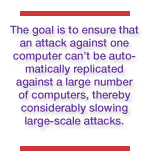|
|
||
|
|
|
Study Uses Genetic Model To Combat Computer Viruses
�
�
Carnegie Mellon professors Mike Reiter and Dawn Song are studying cybersecurity from a biological perspective in collaboration with the University of New Mexico. Their research, which looks at computers the way a physician would look at genetically related patients, is designed to ward off attacks by worms, viruses and other cyberintruders.
�
�
"We are looking at computers the way a physician would look at genetically related patients, each susceptible to the same disorder," said Reiter, a professor of electrical and computer engineering and computer science, and associate director of Carnegie Mellon's CyLab, a university-wide initiative focused on advancing cybersecurity technology and education.
�
"In a population, one member may fall victim to a pathogen or disorder, while another might not have the same vulnerability," Reiter said.
�
"Adapting this idea in biology to computers may not make an individual computer more resilient to attack, but it aims to make the whole population of computers more resilient in aggregate," said Song, assistant professor of electrical and computer engineering and computer science.
�
"We are trying to develop approaches to automatically diversify computers so that attackers will have less information about each individual computer and will have to attack each computer differently," she said.
�
The Internet worm Code Red, for example, infected more than 300,000 systems in less than 13 hours by attacking one major vulnerability. In the case of Code Red, that vulnerability was placing more data into a computer's memory than it could hold.
�
The three-year, $750,000 research project is being funded by the National Science Foundation.
�
�
�
�
�
�
�
Top�
�
�
Chriss Swaney
|
|
This Issue's Headlines || Carnegie Mellon News Home || Carnegie Mellon Home |
||
 Reiter and Song seek to reduce computer vulnerability by automatically changing aspects of a computer's software configuration to render it different from other computers. Their goal is to ensure that an attack against one computer can't be automatically replicated against a large number of computers, thereby considerably slowing large-scale attacks.
Reiter and Song seek to reduce computer vulnerability by automatically changing aspects of a computer's software configuration to render it different from other computers. Their goal is to ensure that an attack against one computer can't be automatically replicated against a large number of computers, thereby considerably slowing large-scale attacks.